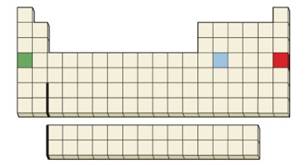
CHEMISTRY-TEXT
8th Edition
ISBN: 9780134856230
Author: Robinson
Publisher: PEARSON
expand_more
expand_more
format_list_bulleted
Concept explainers
Textbook Question
Chapter 6, Problem 6.10A
Conceptual APPLY 6.10 Which of the indicated three elements has the least favorable Eea, and which has the most favorable Eea?

Expert Solution & Answer
Want to see the full answer?
Check out a sample textbook solution
Students have asked these similar questions
Please draw, not just describe!
can you draw each step on a piece of a paper please this is very confusing to me
>
Can the molecule on the right-hand side of this organic reaction be made in good yield from no more than two reactants, in one step, by moderately heating
the reactants?
esc
?
A
O
O
•If your answer is yes, then draw the reactant or reactants in the drawing area below. You can draw the reactants in any arrangement you like.
• If your answer is no, check the box under the drawing area instead.
olo
18
Ar
Explanation
Check
BB
Click and drag to start drawing a structure.
2025 McGraw Hill LLC. All Rights Reserved. Terms of Use | Privacy Center Accessibility
Chapter 6 Solutions
CHEMISTRY-TEXT
Ch. 6 - Prob. 6.1PCh. 6 - APPLY 6.2 Which of the following sets of ions are...Ch. 6 - Which atom or ion has the largest radius:...Ch. 6 - Conceptual APPLY 6.4 Which of the following...Ch. 6 - Use the periodic table to order the elements from...Ch. 6 - Given the orbital filling diagrams for the valence...Ch. 6 - Which has the largest third ionization energy: Be,...Ch. 6 - Conceptual APPLY 6.8 The figure on the right...Ch. 6 - Order the following elements from least to most...Ch. 6 - Conceptual APPLY 6.10 Which of the indicated three...
Ch. 6 - What electron configuration does the strontium...Ch. 6 - Prob. 6.12ACh. 6 - Prob. 6.13PCh. 6 - APPLY 6.14 Calculate the energy of electrostatic...Ch. 6 - Which substance has the largest lattice energy:...Ch. 6 - One of the following pictures represents NaCl and...Ch. 6 - Prob. 6.17PCh. 6 - What structural features do ionic liquids havethat...Ch. 6 - PROBLEM 6.18 Compare the following two ionic...Ch. 6 - PROBLEM 6.19 An ionic liquid consisting of a bulky...Ch. 6 - Where on the periodic table would you find the...Ch. 6 - Which of the following spheres is likely to...Ch. 6 - Circle the approximate part or parts of the...Ch. 6 - Prob. 6.24CPCh. 6 - This figure represents the successive ionization...Ch. 6 - In the following drawings, red spheres represent...Ch. 6 - Which of the following drawings is more likely to...Ch. 6 - Prob. 6.28CPCh. 6 - Which of the following alkali metal halides has...Ch. 6 - Which of the following alkali metal halides has...Ch. 6 - Three binary compounds are represented on the...Ch. 6 - Prob. 6.32CPCh. 6 - Prob. 6.33CPCh. 6 - What is the difference between a covalent bond and...Ch. 6 - Prob. 6.35SPCh. 6 - What is the difference between a molecule and an...Ch. 6 - Prob. 6.37SPCh. 6 - How many protons and electrons are in each of the...Ch. 6 - What is the identity of the element X in the...Ch. 6 - Prob. 6.40SPCh. 6 - Prob. 6.41SPCh. 6 - Prob. 6.42SPCh. 6 - Prob. 6.43SPCh. 6 - What doubly positive ion has the following...Ch. 6 - Prob. 6.45SPCh. 6 - Prob. 6.46SPCh. 6 - Which element in the transition-metal series Sc...Ch. 6 - Prob. 6.48SPCh. 6 - Prob. 6.49SPCh. 6 - Order the following ions from smallest to largest:...Ch. 6 - Order the following ions from smallest to largest:...Ch. 6 - Which ion has a larger atomic radius, Cu+ or Cu2+...Ch. 6 - Which ion hasa larger atomic radius, Fe2+ or Fe3+...Ch. 6 - The following ions all have the same number of...Ch. 6 - Which of the ions Se2,F,O2 and Rb+ has the largest...Ch. 6 - Which group of elements in the periodic table has...Ch. 6 - Prob. 6.57SPCh. 6 - Which element in each of the following sets has...Ch. 6 - Order the elements in each set from the smallest...Ch. 6 - (a) Which has the smaller second ionization...Ch. 6 - (a) Which has the smaller fourth ionization...Ch. 6 - Three atoms have the following electron...Ch. 6 - Three atoms have the following electron...Ch. 6 - The first four ionization energies in kJ/mol of a...Ch. 6 - The first four ionization energies in kJ/mol of a...Ch. 6 - Prob. 6.66SPCh. 6 - Prob. 6.67SPCh. 6 - Prob. 6.68SPCh. 6 - Prob. 6.69SPCh. 6 - Why is energy usually released when an electron is...Ch. 6 - Why does ionization energy increase regularly...Ch. 6 - No element has a negative second electron...Ch. 6 - Why does phosphorus have a less negative electron...Ch. 6 - Prob. 6.74SPCh. 6 - What noble-gas configurations and charge are the...Ch. 6 - Each of the following pairs of elements will react...Ch. 6 - Each of the following pairs of elements will react...Ch. 6 - Element X reacts with element Y to give a product...Ch. 6 - Element X reacts with element Y to give a product...Ch. 6 - Calculate the energy change in kilojoules per mole...Ch. 6 - Prob. 6.81SPCh. 6 - Find the lattice energy of LiBr(s) in Table 6.3,...Ch. 6 - Look up the lattice energies in Table 6.3, and...Ch. 6 - Born-4-Iaber cycles, such as those shown in...Ch. 6 - Calculate a lattice energy for CaH2(s) in...Ch. 6 - Calculate the overall energy change in kilojoules...Ch. 6 - The estimated lattice energy for CsF2(s) is +2347...Ch. 6 - Calculate the overall energy change in kilojoules...Ch. 6 - Use the data in Problem 6.88 to calculate an...Ch. 6 - Use the data and the result in Problem 6.84 to...Ch. 6 - Prob. 6.91SPCh. 6 - Calculate overall energy changes in kilojoules per...Ch. 6 - Prob. 6.93SPCh. 6 - We saw in Section 6.7 that the reaction of solid...Ch. 6 - Draw a Born—Haber cycle for the reaction of sodium...Ch. 6 - Use the following information plus the data given...Ch. 6 - Prob. 6.97SPCh. 6 - Prob. 6.98SPCh. 6 - Order the following compounds according to their...Ch. 6 - Prob. 6.100MPCh. 6 - Heating elemental cesium and platinum together for...Ch. 6 - Given the following information, construct a...Ch. 6 - Consider the electronic structure of the element...Ch. 6 - Prob. 6.104MPCh. 6 - The ionization energy of an atom can be measured...
Knowledge Booster
Learn more about
Need a deep-dive on the concept behind this application? Look no further. Learn more about this topic, chemistry and related others by exploring similar questions and additional content below.Similar questions
- Name the structurearrow_forward> For each pair of substrates below, choose the one that will react faster in a substitution reaction, assuming that: 1. the rate of substitution doesn't depend on nucleophile concentration and 2. the products are a roughly 50/50 mixture of enantiomers. Substrate A Substrate B Faster Rate X CI (Choose one) (Choose one) CI Br Explanation Check Br (Choose one) C 2025 McGraw Hill LLC. All Rights Reserved. Terms of Use | Privacy A F10arrow_forwardHow to draw this mechanism for the foloowing reaction in the foto. thank youarrow_forward
- Predict the major products of the following organic reaction: Some important notes: CN A? • Draw the major product, or products, of the reaction in the drawing area below. • If there aren't any products, because no reaction will take place, check the box below the drawing area instead. • Be sure to use wedge and dash bonds when necessary, for example to distinguish between major products that are enantiomers. No reaction. Explanation Check Click and drag to start drawing a structure. 2025 McGraw Hill LLC. All Rights Reserved. Terms of Use Privacy Centerarrow_forwardDraw the major product of the following reaction. Do not draw inorganic byproducts. H3PO4 OHarrow_forwardPredict the major products of this organic reaction: HBr (1 equiv) Δ ? Some important notes: • Draw the major product, or products, of this reaction in the drawing area below. • You can draw the products in any arrangement you like. • Pay careful attention to the reaction conditions, and only include the major products. • Be sure to use wedge and dash bonds when necessary, for example to distinguish between major products that are enantiomers. • Note that there is only 1 equivalent of HBr reactant, so you need not consider the case of multiple additions. Explanation Check X ©2025 McGraw Hill LLC. All Rights Reserved. Terms of Use | Privacyarrow_forward
- For the structure below, draw the resonance structure that is indicated by the curved arrow(s). Be sure to include formal charges. :ÖH Modify the second structure given to draw the new resonance structure. Include lone pairs and charges in your structure. Use the + and - tools to add/remove charges to an atom, and use the single bond tool to add/remove double bonds.arrow_forwardUsing the table of Reactants and Products provided in the Hints section, provide the major product (with the correct stereochemistry when applicable) for questions below by selecting the letter that corresponds to the exact chemical structures for the possible product. OH conc Hydrochloric acid 40°C Temp A/arrow_forwardUsing arrows to designate the flow of electrons, complete the reaction below and provide a detailed mechanism for the formation of the product OH conc Hydrochloric acid 40°C Temp All chemical structures should be hand drawn on a piece of paper Paragraph BI UAE +varrow_forward
- draw out the following structures plesearrow_forwardDraw everything on a piece of paper outlining the synthesis from acetaldehyde to 2 cyclopentene carboxaldehyde using carbon based reagants with 3 carbons or fewers. Here is the attached image.arrow_forwardManoharan Mariappan, FR.D., 34) Complete the following reaction starting from hex-1-yne proceeding via different substitution reactions forming 2-heptanone. (25 pts). A Sia₂BH H₂O₂ NaOH Br D Mechanism for reaction D - ether-cleavage: 10 B Ph-MgCI, THF H₁₂O+ D HBr (XS) C TsCl, Py CH3-CH2-CH2-ONaarrow_forward
arrow_back_ios
SEE MORE QUESTIONS
arrow_forward_ios
Recommended textbooks for you
 Chemistry: An Atoms First ApproachChemistryISBN:9781305079243Author:Steven S. Zumdahl, Susan A. ZumdahlPublisher:Cengage Learning
Chemistry: An Atoms First ApproachChemistryISBN:9781305079243Author:Steven S. Zumdahl, Susan A. ZumdahlPublisher:Cengage Learning Chemistry for Engineering StudentsChemistryISBN:9781337398909Author:Lawrence S. Brown, Tom HolmePublisher:Cengage Learning
Chemistry for Engineering StudentsChemistryISBN:9781337398909Author:Lawrence S. Brown, Tom HolmePublisher:Cengage Learning Chemistry: Principles and PracticeChemistryISBN:9780534420123Author:Daniel L. Reger, Scott R. Goode, David W. Ball, Edward MercerPublisher:Cengage Learning
Chemistry: Principles and PracticeChemistryISBN:9780534420123Author:Daniel L. Reger, Scott R. Goode, David W. Ball, Edward MercerPublisher:Cengage Learning Introductory Chemistry: A FoundationChemistryISBN:9781337399425Author:Steven S. Zumdahl, Donald J. DeCostePublisher:Cengage Learning
Introductory Chemistry: A FoundationChemistryISBN:9781337399425Author:Steven S. Zumdahl, Donald J. DeCostePublisher:Cengage Learning

Chemistry: An Atoms First Approach
Chemistry
ISBN:9781305079243
Author:Steven S. Zumdahl, Susan A. Zumdahl
Publisher:Cengage Learning

Chemistry for Engineering Students
Chemistry
ISBN:9781337398909
Author:Lawrence S. Brown, Tom Holme
Publisher:Cengage Learning

Chemistry: Principles and Practice
Chemistry
ISBN:9780534420123
Author:Daniel L. Reger, Scott R. Goode, David W. Ball, Edward Mercer
Publisher:Cengage Learning

Introductory Chemistry: A Foundation
Chemistry
ISBN:9781337399425
Author:Steven S. Zumdahl, Donald J. DeCoste
Publisher:Cengage Learning
Atomic Number, Atomic Mass, and the Atomic Structure | How to Pass ChemistryThe Nucleus: Crash Course Chemistry #1; Author: Crash Course;https://www.youtube.com/watch?v=FSyAehMdpyI;License: Standard YouTube License, CC-BY